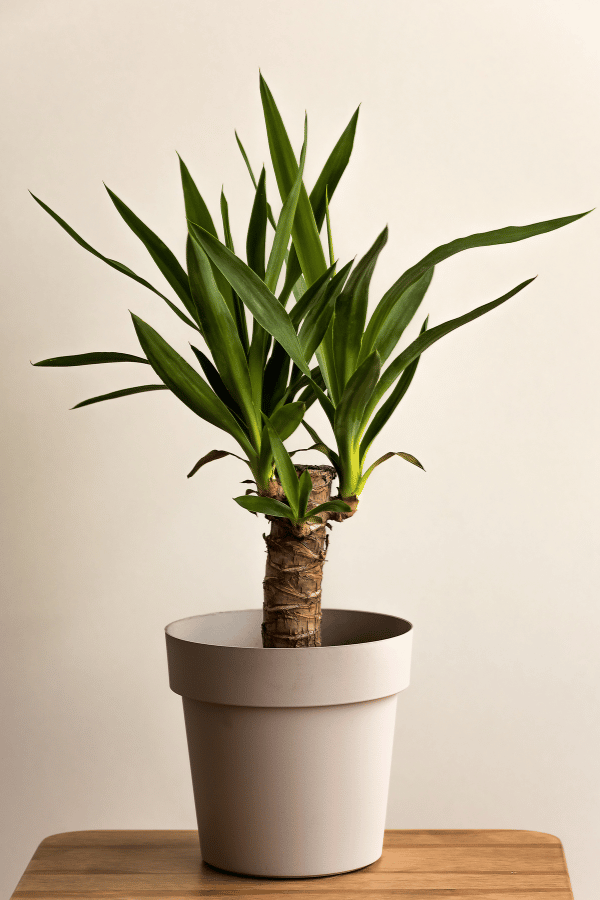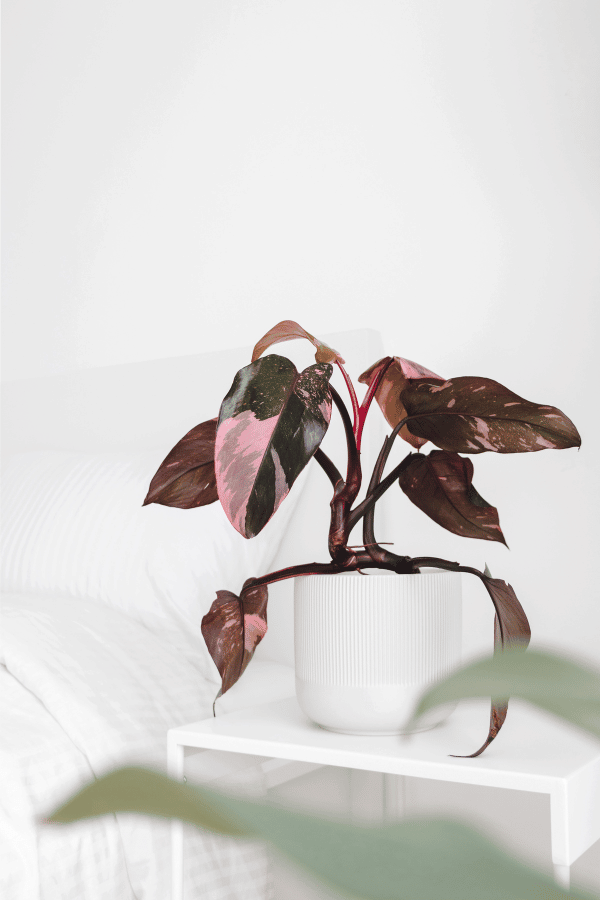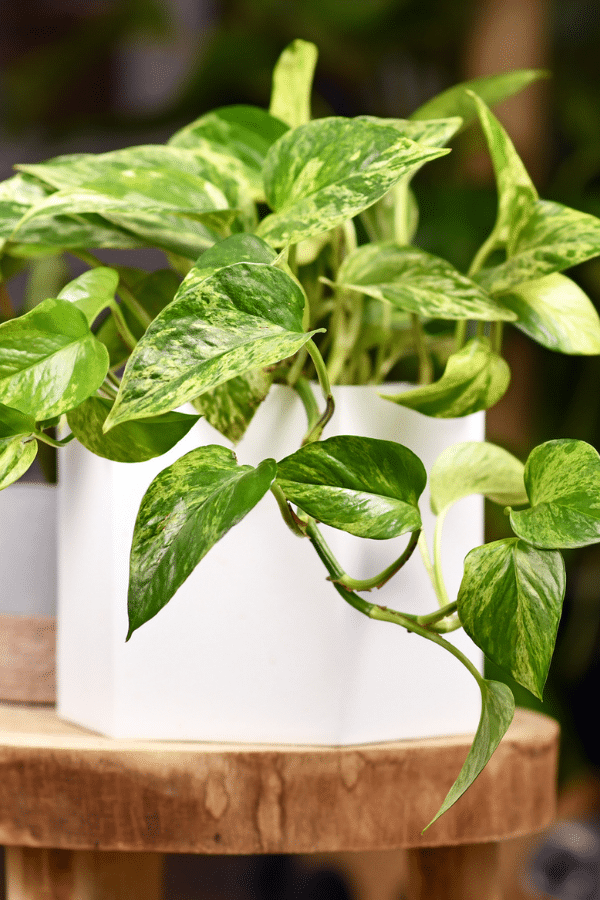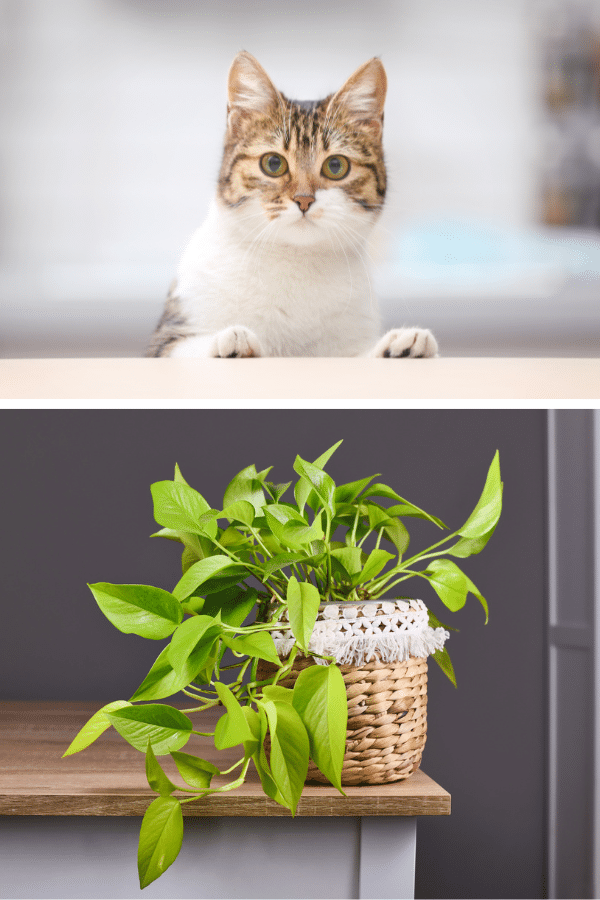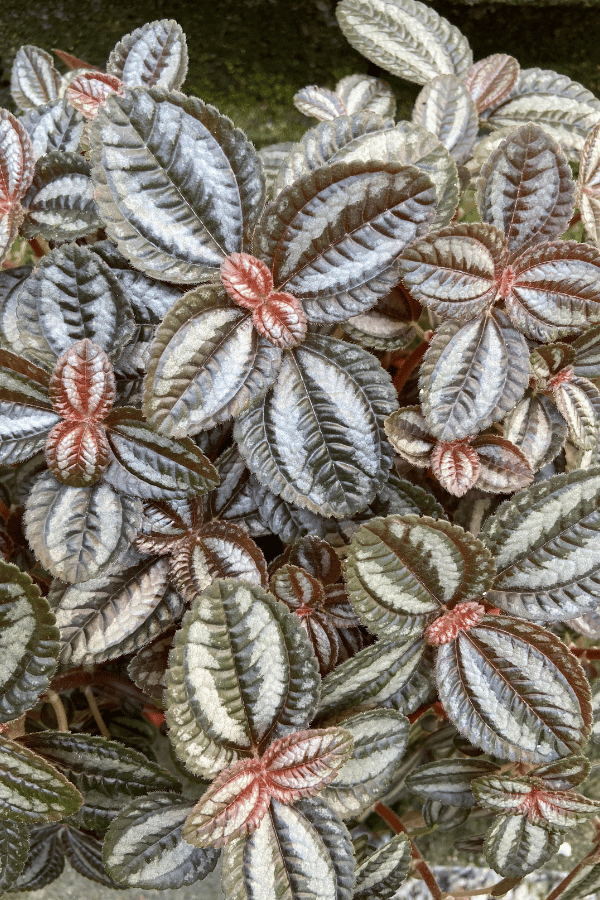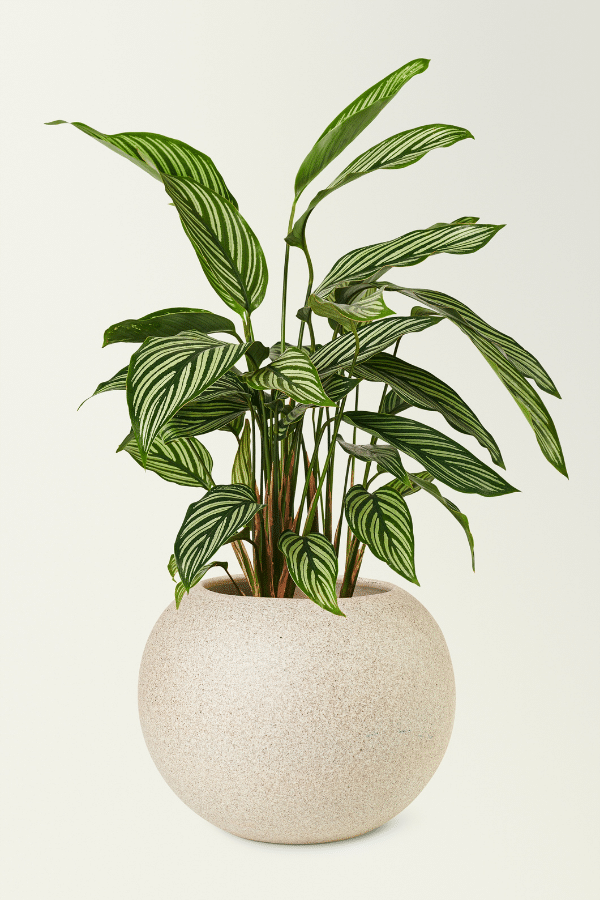Calathea Orbifolia
Scientific Name: Calathea Orbifolia
Common Name: Prayer Plant
Calathea Orbifolia’s have gorgeous and attractive leaves, making them a really unique houseplant. Calathea Orbifolia care can be harder than most other houseplants due to their need for optimal environmental conditions. If not given these conditions, they can wilt, droop, lose leaves, or die because of it. So before bringing home a Calathea Orbifolia, get the optimal care guide for this indoor plant.
Quick Care Overview
| Common Name | Prayer Plant |
| Scientific Name | Calathea Orbifolia |
| Family | Marantaceae |
| Origin | Bolivia |
| Identification | Vibrant green leaves with silver stripes |
| Height | 3 feet tall |
| Soil | Well-draining soil + moisture retention |
| Water | Allow top two inches of soil to dry out before watering |
| Temperature | 60-75F |
| Sunlight | Moderate, indirect sunlight |
| Toxic to Cats & Dogs | No |
| Toxic to Humans | No |
| Pests | Aphids, mealybugs, spider mites, thrips, whitefly |
| Diseases | Powdery mildew, bacterial leaf spot, fungal root decay, soil mold |
Below we will dive deep into how to care for Calathea Orbifolia.
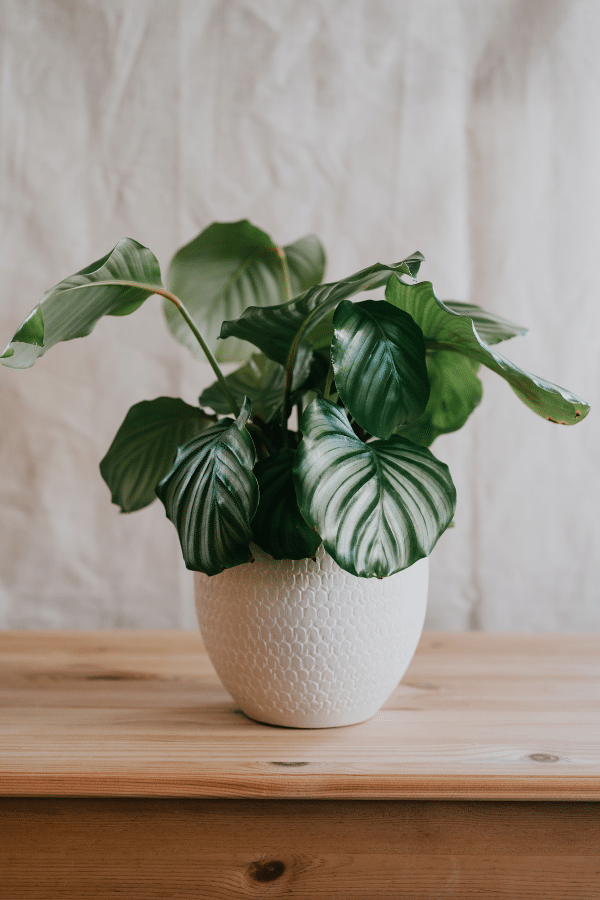
Calathea Orbifolia History
Bolivia native, Calathea Orbifolia, also known as the Orbifolia prayer plant, is becoming increasingly popular amongst houseplant lovers. Calathea Orbifolia has showy, round-shaped foliage that has led to it being named after the Latin term “orbis”, which means circular. Like other prayer plants, the leaves of Calathea Orbifolia shift and move, with leaves often liftering at night and folding down to their starting position in the daytime. Although many plant retailers still label this plant as Calathea Orbifolia, it has recently been reclassified under the Genus Goeppertia.
Calathea Orbifolia Identification
The Orbifolia prayer plant can be identified by its vibrant, bright-green leaves lashed with silvery stripes. The slightly curled-edged leaves are quite large and lush, reaching around 10 inches long when fully mature, creating the appearance of a very full-bodied plant.
Calathea Orbifolia Growth Facts
Calathea Orbifolia is absolutely an attention-grabber with distinct round foliage that can grow up to a foot wide on average!
How Big Does a Calathea Orbifolia Get?
This plant often reaches a maximum height of 3 feet tall by 3 feet wide when grown indoors as a houseplant.

Calathea Orbifolia Care
While not considered to be a plant for beginners, Calathea Orbifolia care requires some extra maintenance.
Best Soil for Calathea Orbifolia
The Orbifolia prayer plant will enjoy a well-draining potting soil that also has a high-moisture retention rate. A standard potting mix with incorporations of perlite and/or orchid bark will do quite nicely.
Calathea Orbifolia Fertilizer
The Orbifolia prayer plant does not require much fertilization. During the warm growing season, a light, nitrogen-based, liquid fertilizer labeled for houseplants may be used to encourage foliar growth. Don’t fertilize during the winter months or non-active growing months.
Calathea Orbifolia Watering
Being a tropical plant, Calathea Orbifolia requires moist soil that is not overly saturated with water. It enjoys deep, even waterings. Ensure that you do not leave the drainage water pooled in the tray. Being vulnerable to root rot, it is important not to overwater this plant by utilizing well-draining soil. It is critical when watering to use either filtered water, distilled water, or rainwater, as this plant is extremely sensitive to the chemicals in tap water. It is also important to note, that unlike other houseplants, Calathea Orbifolia’s leaves will not wilt when thirsty. Understanding this will help to determine a watering schedule. Water only after the top inch of soil has become dry.
Calathea Orbifolia Light Requirements
Calathea Orbifolia enjoys moderate, indirect light. This plant is very sensitive to direct sunlight which can burn the leaves very easily. Calathea Orbifolia can endure some shade, but too much darkness will cause discoloration of the leaves and stunted growth. An eastern or north-facing window will suit this plant wonderfully.
Calathea Orbifolia Temperature & Humidity
The Orbifolia plant enjoys an average temperature range between 60 to 75 degrees Fahrenheit. However, with proper humidity, it can tolerate even higher temperatures, but may be subject to leaf curling. Avoid exposure to temperatures below 55 degrees Fahrenheit, as this can be permanently damaging. High humidity levels is of utmost importance for the Calathea Orbifolia plant. The ideal humidity level is between 55-70%. Lower humidity levels will cause your prayer plant to struggle. To remedy this, add a humidifier or a pebble tray. Alternatively, you may grow your Calathea in a bathroom if there is adequate light.
Repotting Calathea Orbifolia
Repotting of your prayer plant should be done during the growing season of spring or summer. As a general rule, repotting should only be done after your prayer plant has become root-bound and you notice roots appearing from out of the drainage holes. If you don’t see these signs, leave your Calathea Orbifolia in the same planter it lives in now. To repot, simply select a container that is one to two inches larger than the current pot and one that has a drainage hole. Lightly squeeze the container to release the soil and root ball, place potting mix in the new container, and make a hole large enough to accommodate the root ball. Add the root ball, insert more well-aerated soil, and then give the newly potted plant a good watering. The plant will show signs of distress after repotting but should perk back up and resume growth within a few months.
Calathea Orbifolia Maintenance & Pruning
Calathea Orbifolia care does not require pruning very regularly. This is because the leaves of the prayer plant are single-stemmed and there are not any branches to prune. To remove yellow, brown, or discolored leaves, simply trim at the base of the stem with clean, sterilized shears. One maintenance item the Calathea Orbifolia plants need is to wipe off the dust on the leaves with a damp cloth every other week.

Propagating Calathea Orbifolia
Rhizome division is the best method to propagate Calathea Orbifolia. It is important to note that this prayer plant cannot be propagated from stem cuttings and propagations should be done in spring. To make a rhizome division, simply retrieve the mother plant from the container and loosen the soil around the rhizome. Cut a portion of rhizome that contains a few roots and leaves using a sharp, sterilized blade. Next, place the rhizome into a new pot that contains well-aerated soil with ample drainage. Water the planted rhizome thoroughly and keep in indirect light. Be careful to not overwater this plant as it’s much smaller than the mother plant and therefore, needs less water to grow.
Calathea Orbifolia Toxicity
Calathea Orbifolia is non-toxic to humans, cats, and dogs. But still, do not ingest this plant.
Toxicity to Humans
Calathea Orbifolia is considered non-toxic to humans.
Toxicity to Cats & Dogs
Calathea Orbifolia is considered non-toxic to pets. If you’re looking for a pet-friendly houseplant, here it is!
Calathea Orbifolia Problems
Calathea Orbifolia Leaves Turning Yellow
Overwatering is the most common cause of yellowing leaves. Ensure that you are utilizing a soil mix that has ample drainage and are not leaving water sitting in the plant’s tray. However, low humidity may also cause yellowing of leaves that will also likely exhibit curling and browning of the leaf edge.
Calathea Orbifolia Leaves Turning Brown
When the leaves of a Calathea Orbifolia turn brown, it is typically a sign of underwatering. This plant is also very sensitive to chemicals in tap water, which may also lead to discoloring. If you discover brown edges on Calathea Orbifolia, give the plant a deep watering with water that is either filtered, distilled, or rainwater and let the water drain from the drainage holes in a sink or bathtub.
Calathea Orbifolia Diseases
The humid, damp growing conditions required for Calathea Orbifolia make them prone to fungal diseases. Powdery mildew, leaf spot, fungal root decay, and white soil mold may all affect this plant’s growth. Proper watering, air flow, and adequate temperatures can help to reduce instances of fungal disease. If disease is suspected, treat with a fungicide following all label instructions.
Calathea Orbifolia Pests
Several pests can commonly affect the Orbifolia prayer plant, including mealybugs, spider mites, thrips, aphids, whitefly, and others. At first sign of infestation, treat with a pesticide, such as neem oil or insecticidal soap. Isolate the plant to avoid pests spreading to other houseplants.
FAQ
Is Calathea Orbifolia Hard to Care for?
The Calathea Orbifolia is a medium maintenance houseplant. There are specific environments this plant needs in order to grow well from lighting, soil, and watering. Anything outside the optimal conditions will cause the plant to droop, wilt, and lose color.
How Often Should You Water Calathea Orbifolia?
The Calathea Orbifolia needs to be watered only after the top one to two inches of soil is dry. When watering, water completely and let the water come through the drainage hole at the bottom. Discard that water and don’t let it sit in the plants tray to avoid root rot.
Is Calathea Orbifolia Fast Growing?
Calathea Orbifolia indoor plant is not a fast growing houseplant. Using fertilizer in spring and summer can help the plant to grow faster.
Where Should I Put Calathea Orbifolia?
Placing your Calathea Orbifolia is of utmost importance to it growing well. Place it away from windows, drafts, air vents, and give it a spot where it will receive low to moderate lighting.

